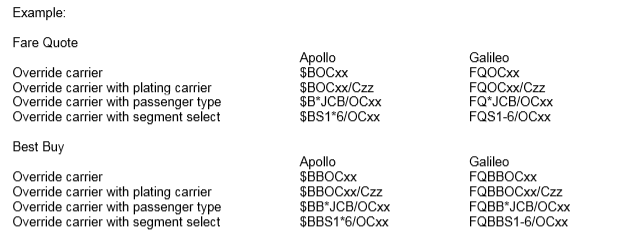Fare Selection
IATA split the world into three Traffic Conferences (TC1/2/3)

Fare Selection Criteria will consider up to two potential carrier’s fares for a fare component. The carrier’s fare that will be selected for the fare component will be the lower of the two fares based on a comparison between Options 1 and 2 below, assuming each fare passes all rules.
• Option 1 for fare selection: Most significant carrier (carrier used in the current fare selection process).
- The first sector crossing from one Area to another Area, if none then
- The first sector crossing from one sub-area to another, if none then
- The first international sector
• Option 2 for fare selection: The carrier that provides air travel for the longest measured TPMs (Ticketed Point Miles)
1. The longest international sector, OR
2. The longest consecutive international sectors, OR
3. The longest consecutive international and domestic sectors.
Rule Validation
When a carrier is selected to be the fare owning carrier for the fare component, that carrier is then considered to be “primary” carrier on the Fare Component for the purposes of RBD (Reservation Booking Designators) and Transfers – Category 9.
The fare for the carrier selected to be used on the Fare Component must pass all fare rules (e.g. routing/mileage, stopovers, transfers, surcharges, combinations, RBDs, etc.).
Determining the Fare Owning Carrier on a Fare Quote
After pricing the itinerary, the agent will be able to determine the carrier that was selected to be the fare owning carrier on each fare component using a follow-on entry.
- Galileo Follow-On entry after FQ – FQL
- Apollo Follow-On entry after $B – FQL
- Worldspan Follow-On entry 4P – 4PR
Significant Carrier
1. The carrier crossing one area to another / The first carrier crossing from one area to another
Excepting Travel TC123 where you choose the fare from transatlantic carrier
2. The carrier crossing one subarea to another / The first carrier crossing from one sub-area to another
3. The carrier performing the first international sector (except Europe)
- Within Europe: select the lower of the fares applicable for the carrier performing carriage on the first international sector, and the carrier performing the greatest part of the journey measured by TPM. Compare the fares of the two carriers, and apply the lower.
Travel within Scandinavia (Norway, Sweden and Denmark) is considered international for this rule
Domestic Fares except Within USA/Canada: When a domestic fare component involves two carriers (generally there will not be more than two carriers involved in a domestic fare), compare the fares of the two carriers, and apply the lower.
Domestic Fares within USA/Canada (ONE COUNTRY): for fare components within US/CA, select the fare for the carrier performing the service on the first sector.
Carrier Fares and IATA Fares
When applying the fare selection criteria explained above, select the IATA fare if the carrier has not filed a fare between the origin and destination of the fare component.
Between TC1 and TC2
When the fare component is between area 1 and area 2 via the Atlantic,
the fares of the carrier performing service on the sector crossing from one area to another is used.
Between TC1 and TC3
When the fare component is between area 1 and area 3 via the Pacific,
the fares of the carrier performing service on the sector crossing from one area to another is used.
Between TC2 and TC3
When the fare component is between area 2 and area 3, the fares of the
carrier performing service on the sector crossing from one area to another is used.

Between TC1 and TC3 via TC2
When the fare component is between area 1 and area 3 via area 2, the fares of the carrier performing service on the sector crossing between area 1 and area 2 – the transatlantic carrier – is used.
Between TC2 and TC3 via TC1
When the fare component is between area 2 and area 3 via area 1, the fares of the carrier performing service on the first sector crossing from one area to another will be used. Fare selection is applied in the direction in which the fare is assessed. When an itinerary contains a fare component which returns to the country of origin, the fare is assessed from the country of origin. In this circumstance the fares of the carrier performing service on the first sector crossing from one area to another in the direction of the fare is used.
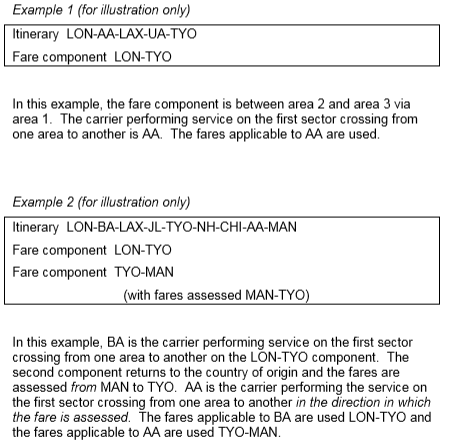
Between TC1 and TC2 via TC3
When the fare component is between area 1 and area 2 via area 3, the fares of the carrier performing service on the first sector crossing from one area to another will be used. Fare selection is applied in the direction in which the fare is assessed. When an itinerary contains a fare component which returns to the country of origin, the fare is assessed from the country of origin. In this circumstance the fares of the carrier performing service on the first sector crossing from one area to another in the direction of the fare are used.
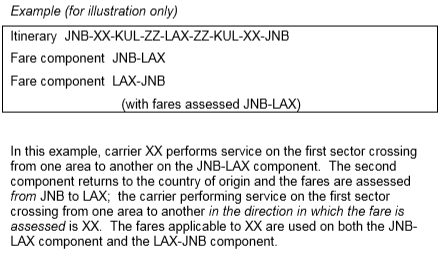
When the fare component is between sub-areas, the fares of the carrier performing service on the sector crossing from one sub-area to another are used.
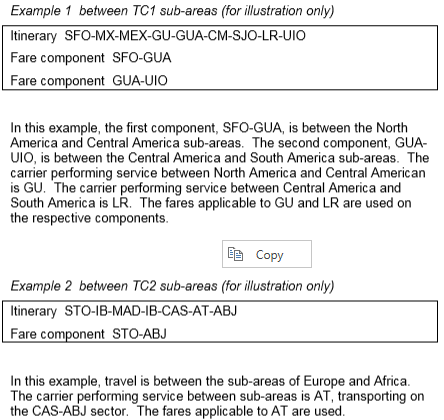
More than one area crossing
When a fare component is between areas and contains more than one area crossing, the fares of the carrier performing service on the first sector crossing from one area to another will be used. Fare selection is applied in the direction in which the fare is assessed. For fare components returning to the country of origin, and for which the fares are assessed from the country of origin, the fares of the carrier performing service on the first sector crossing from one area to another in the direction of the fare are used.
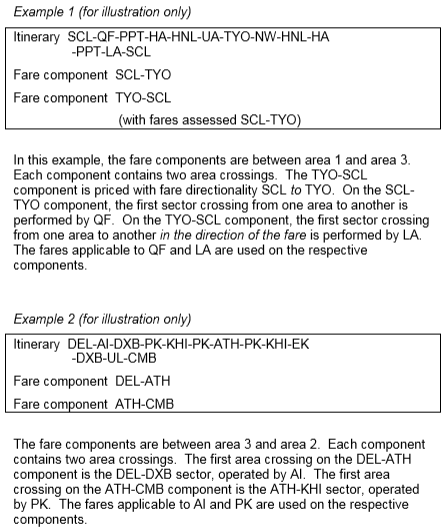
More than one sub-area crossing
When a fare component is between sub-areas and contains more than one sub-area crossing, the fares of the carrier performing service on the first sector crossing from one sub-area to another are used. Fare selection is applied in the direction in which the fare is assessed. For fare components returning to the country of origin, and for which the fares are assessed from the country of origin, the fares of the carrier performing service on the first sector crossing from one sub-area to another in the direction of the fare are used.
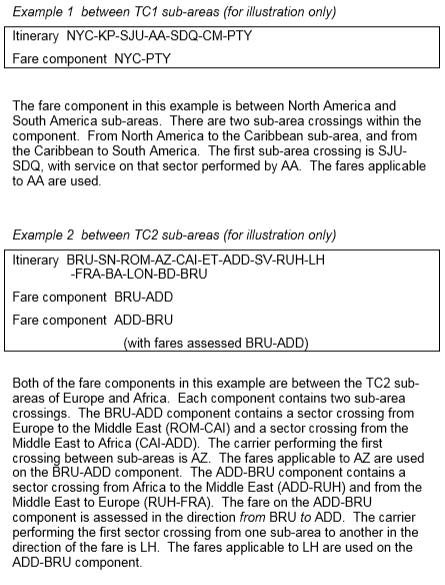
When the fare component is within a sub-area, the fares of the carrier performing service on the first international sector are used. When a fare component returns to the country of origin and the fares are assessed from the country of origin, the fares of the carrier performing service on the first international sector in the direction of the fare are used.
Note: Travel between Canada and USA is not considered international travel.
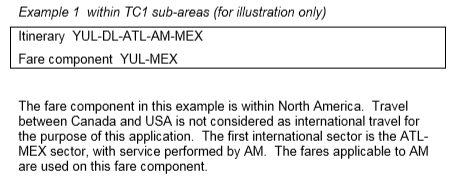
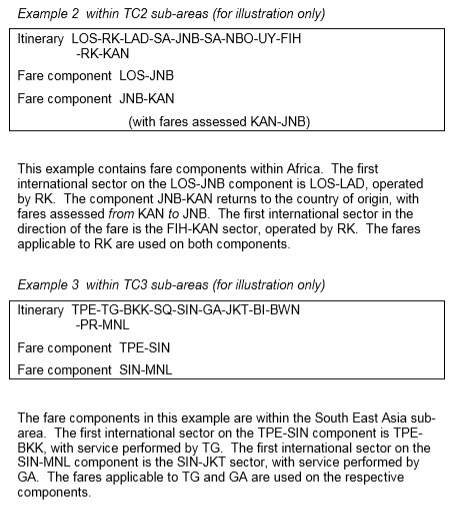
When a fare component is within the TC2 sub-area of Europe, the fares of the carrier performing service on the first international sector or the fares of the carrier performing service on the longest sector(s) measured by TPM, whichever is lower, are used. For fare components returning to the country of origin, with fares assessed from the country of origin, the comparison will be made between the carrier performing service on first international sector in the direction of the fare and the carrier performing service on the longest sector(s) measured by TPM.
Note: Travel between Denmark, Norway and Sweden is considered as international travel.

When the sector which determines fare selection is a surface sector, the YY fares is used as the applicable fares for the component.

When domestic fare components involve more than one carrier, the fares of two carriers are retrieved for a fare quote attempt. If both carrier’s fares pass rules validation, the fares of the carrier offering the lower fare is quoted. If only one carrier actually offers fares for the city pair, that carrier’s fares are quoted without regard to the carrier’s disposition within the component.
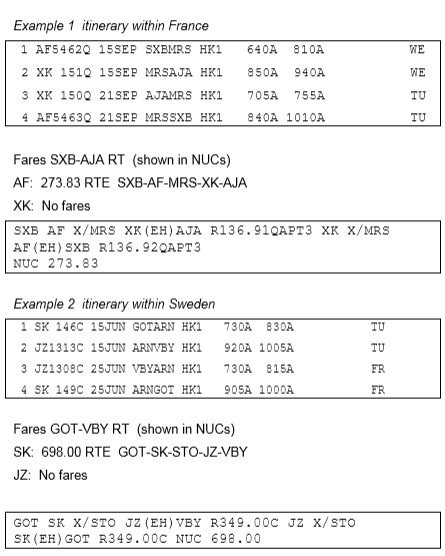
Determining the Fare Owning Carrier on a Fare Quote
After pricing the itinerary, the agent will be able to determine the carrier that was selected to be the fare owning carrier on each fare component using a follow-on entry.
- Galileo Follow-On entry after FQ – FQL
- Apollo Follow-On entry after $B – FQL
- Worldspan Follow-On entry 4P – 4PR
1G/V example below Carrier is XX on both fare components
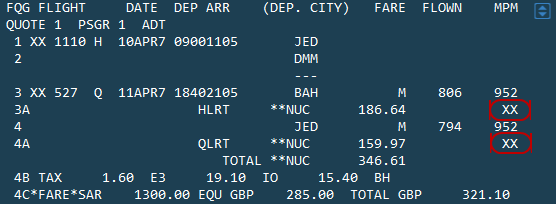
1P example
When there are multiple fare components included in the fare quote, the fare owning carrier is displayed with each associated fare component with the Follow-On entry of 4PR
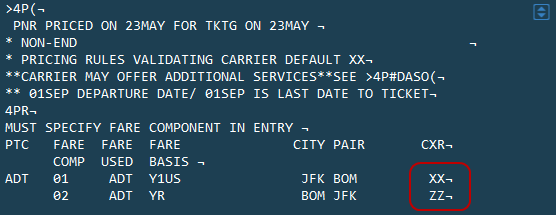
Domestic Routes via International Points
360 Fares processing logic will not return domestic fares for an itinerary that includes an inter-country connection point when the traveled mileage is greater than three times the fare component's
origin/destination mileage.
Example:

Overiding the Fare Selection Carrier - OC Modifier
You can tell the system to apply the fare of any airline in the itinerary to overide the default IATA Fare Selection Policy.
Important : Using this modifier will result in am M status fare which is not covered by the Travelport Fare Guarantee Policy and therefore not eligible for ADM research.
